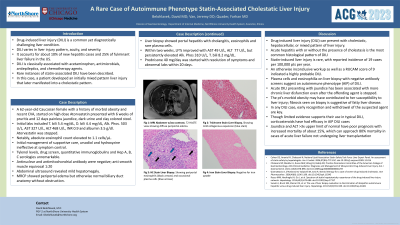Sunday Poster Session
Category: Liver
P1103 - A Rare Case of Autoimmune Phenotype Statin-Associated Cholestatic Liver Injury
Sunday, October 22, 2023
3:30 PM - 7:00 PM PT
Location: Exhibit Hall

Has Audio

David Belohlavek, MD
University of Chicago Northshore
Evanston, IL
Presenting Author(s)
David Belohlavek, MD1, Jeremy Van, DO2, Omar Khan, MD3
1University of Chicago Northshore, Evanston, IL; 2University of Chicago/Northshore University, Evanston, IL; 3North Shore University Health System, Evanston, IL
Introduction: Drug-induced liver injury (DILI) is a common yet diagnostically challenging liver condition. DILI varies in liver injury pattern, acuity, and severity. It accounts for about 10% of new hepatitis cases and 25% of fulminant liver failure in the US and is classically associated with acetaminophen, antimicrobials, antiepileptics, and chemotherapy agents. Rare instances of statin-associated DILI have been described. In this case, a patient (pt) developed an initially mixed statin associated liver injury that later manifested into a cholestatic pattern.
Case Description/Methods: A 62-year-old Caucasian female with a history of morbid obesity and CVA presented with 6 weeks of pruritis and 12 days painless jaundice, dark urine and clay colored stool. She denied recent illness, alcohol or herbal supplement use. She had normal LFTs prior to starting 80 mg atorvastatin daily. Within two weeks of initiation, she developed progressive pruritis. Initial labs included a total bilirubin (T. bili) 5.4 mg/dL, direct bilirubin (D. bili) 4.4 mg/dL, alkaline phosphatase (ALP) 503 U/L, AST 327 U/L, ALT 468 U/L, INR 0.9 and albumin 3.5 g/dl. Her statin was stopped. Abdominal ultrasound revealed mild hepatomegaly. Workup including Tylenol levels, drug screen, quantitative immunoglobulins and Hep A, B, C serologies was unremarkable. Autoimmune studies including ANA screen and AMA were negative; ASMA 1:20. MRCP showed periportal edema but otherwise normal biliary duct anatomy without obstruction. Liver biopsy showed portal hepatitis with cholangitis, eosinophils and rare plasma cells. Two weeks later, labs revealed AST 49 U/L, ALT 77 U/L, but persistently elevated ALP 310 U/L, T. bili 8.2 mg/dL. Eosinophil count was 1.1 cells/µL. As initial conservative treatment was ineffective, prednisone was trialed successfully with resolution of symptoms and abnormal labs within 20 days.
Discussion: Statin-induced liver injury is rare, with reported incidence of 19 cases per 100,000 pts per year. An inconclusive workup as well as a RUCAM score of 9 indicated a highly probable DILI. Strikingly, plasma cells on liver biopsy, ASMA 1:20, and eosinophilia suggest an autoimmune phenotype (AIP), previously defined in the DILI Network study. The pt’s age, gender, and obesity may have contributed to her susceptibility. In any DILI case, early recognition and withdrawal of the suspected agent are key. Though limited evidence supports their use in typical DILI, corticosteroids have had efficacy in AIP DILI cases associated with statin use.
Disclosures:
David Belohlavek, MD1, Jeremy Van, DO2, Omar Khan, MD3. P1103 - A Rare Case of Autoimmune Phenotype Statin-Associated Cholestatic Liver Injury, ACG 2023 Annual Scientific Meeting Abstracts. Vancouver, BC, Canada: American College of Gastroenterology.
1University of Chicago Northshore, Evanston, IL; 2University of Chicago/Northshore University, Evanston, IL; 3North Shore University Health System, Evanston, IL
Introduction: Drug-induced liver injury (DILI) is a common yet diagnostically challenging liver condition. DILI varies in liver injury pattern, acuity, and severity. It accounts for about 10% of new hepatitis cases and 25% of fulminant liver failure in the US and is classically associated with acetaminophen, antimicrobials, antiepileptics, and chemotherapy agents. Rare instances of statin-associated DILI have been described. In this case, a patient (pt) developed an initially mixed statin associated liver injury that later manifested into a cholestatic pattern.
Case Description/Methods: A 62-year-old Caucasian female with a history of morbid obesity and CVA presented with 6 weeks of pruritis and 12 days painless jaundice, dark urine and clay colored stool. She denied recent illness, alcohol or herbal supplement use. She had normal LFTs prior to starting 80 mg atorvastatin daily. Within two weeks of initiation, she developed progressive pruritis. Initial labs included a total bilirubin (T. bili) 5.4 mg/dL, direct bilirubin (D. bili) 4.4 mg/dL, alkaline phosphatase (ALP) 503 U/L, AST 327 U/L, ALT 468 U/L, INR 0.9 and albumin 3.5 g/dl. Her statin was stopped. Abdominal ultrasound revealed mild hepatomegaly. Workup including Tylenol levels, drug screen, quantitative immunoglobulins and Hep A, B, C serologies was unremarkable. Autoimmune studies including ANA screen and AMA were negative; ASMA 1:20. MRCP showed periportal edema but otherwise normal biliary duct anatomy without obstruction. Liver biopsy showed portal hepatitis with cholangitis, eosinophils and rare plasma cells. Two weeks later, labs revealed AST 49 U/L, ALT 77 U/L, but persistently elevated ALP 310 U/L, T. bili 8.2 mg/dL. Eosinophil count was 1.1 cells/µL. As initial conservative treatment was ineffective, prednisone was trialed successfully with resolution of symptoms and abnormal labs within 20 days.
Discussion: Statin-induced liver injury is rare, with reported incidence of 19 cases per 100,000 pts per year. An inconclusive workup as well as a RUCAM score of 9 indicated a highly probable DILI. Strikingly, plasma cells on liver biopsy, ASMA 1:20, and eosinophilia suggest an autoimmune phenotype (AIP), previously defined in the DILI Network study. The pt’s age, gender, and obesity may have contributed to her susceptibility. In any DILI case, early recognition and withdrawal of the suspected agent are key. Though limited evidence supports their use in typical DILI, corticosteroids have had efficacy in AIP DILI cases associated with statin use.
Disclosures:
David Belohlavek indicated no relevant financial relationships.
Jeremy Van indicated no relevant financial relationships.
Omar Khan indicated no relevant financial relationships.
David Belohlavek, MD1, Jeremy Van, DO2, Omar Khan, MD3. P1103 - A Rare Case of Autoimmune Phenotype Statin-Associated Cholestatic Liver Injury, ACG 2023 Annual Scientific Meeting Abstracts. Vancouver, BC, Canada: American College of Gastroenterology.
